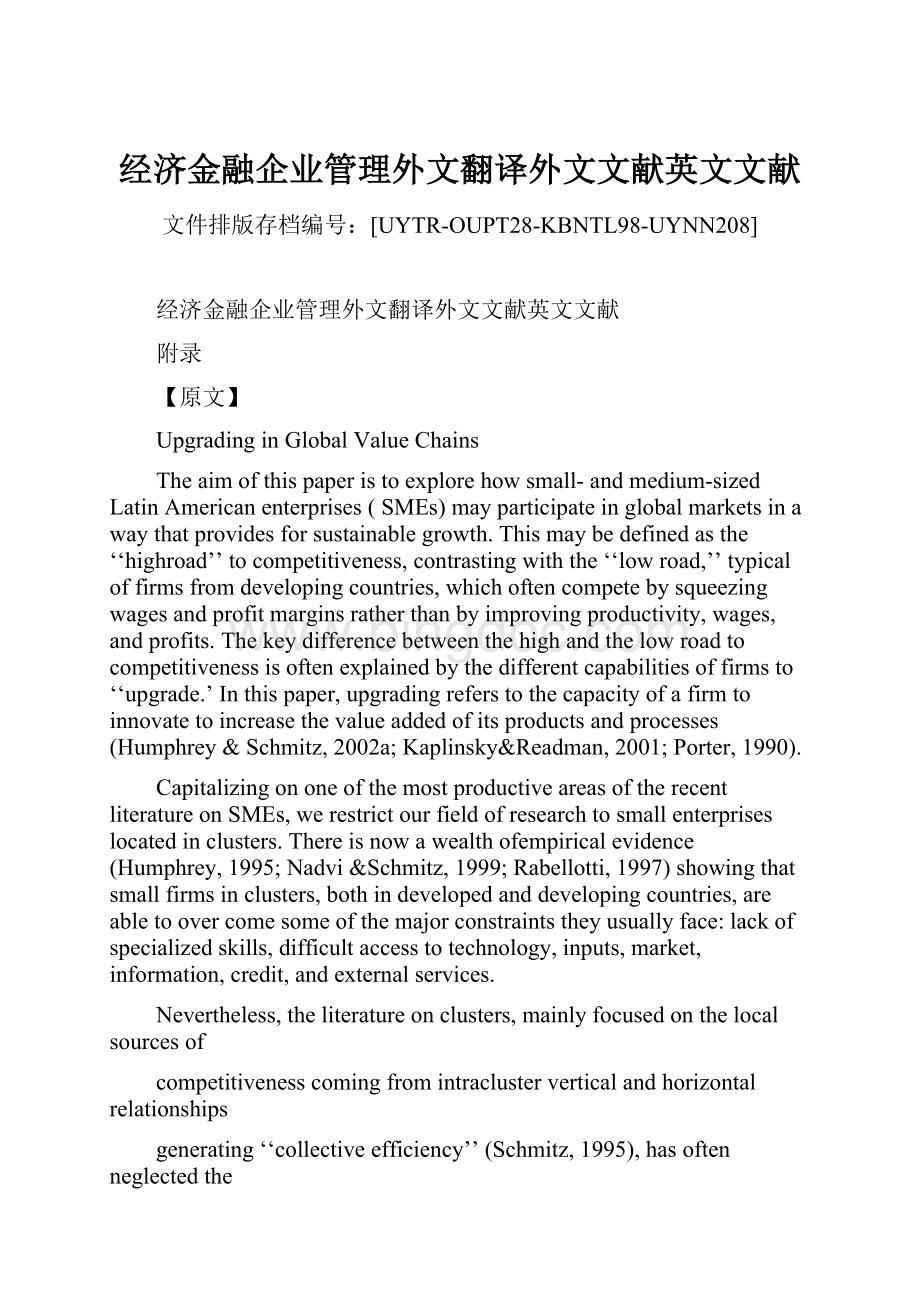经济金融企业管理外文翻译外文文献英文文献Word格式.docx
《经济金融企业管理外文翻译外文文献英文文献Word格式.docx》由会员分享,可在线阅读,更多相关《经济金融企业管理外文翻译外文文献英文文献Word格式.docx(28页珍藏版)》请在冰点文库上搜索。

Kaplinsky&
Readman,2001;
Porter,1990).
CapitalizingononeofthemostproductiveareasoftherecentliteratureonSMEs,werestrictourfieldofresearchtosmallenterpriseslocatedinclusters.Thereisnowawealthofempiricalevidence(Humphrey,1995;
Nadvi&
Schmitz,1999;
Rabellotti,1997)showingthatsmallfirmsinclusters,bothindevelopedanddevelopingcountries,areabletoovercomesomeofthemajorconstraintstheyusuallyface:
lackofspecializedskills,difficultaccesstotechnology,inputs,market,information,credit,andexternalservices.
Nevertheless,theliteratureonclusters,mainlyfocusedonthelocalsourcesof
competitivenesscomingfromintraclusterverticalandhorizontalrelationships
generating‘‘collectiveefficiency’’(Schmitz,1995),hasoftenneglectedthe
increasingimportanceofexternallinkages.Duetorecentchangesinproduction
systems,distributionchannels,andfinancialmarkets,andtothespreadofinformation
technologies,enterprisesandclustersareincreasinglyintegratedinvaluechainsthat
oftenoperateacrossmanydifferentcountries.Theliteratureonglobalvaluechains
(GVCs)(Gereffi,1999;
Gereffi&
Kaplinsky,2001)callsattentiontotheopportunities
forlocalproducerstolearnfromthegloballeadersofthechainsthatmaybebuyersor
1
producers.Theinternalgovernanceofthevaluechainhasanimportanteffectonthescopeoflocalfirms’upgrading(Humphrey&
Schmitz,2000).
Indeed,extensiveevidenceonLatinAmericarevealsthatboththelocalandtheglobaldimensionsmatter,andfirmsoftenparticipateinclustersaswellasinvaluechains(Pietrobelli&
Rabellotti,2004).Bothformsoforganizationofferopportunitiestofostercompetitivenessvialearningandupgrading.However,theyalsohaveremarkabledrawbacks,as,forinstance,upgradingmaybelimitedinsomeformsofvaluechains,andclusterswithlittledevelopedexternaleconomiesandjointactionsmayhavenoinfluenceoncompetitiveness.
Moreover,bothstrandsofliteraturewereconceivedanddevelopedtoovercomethesectoraldimensionintheanalysisofindustrialorganizationanddynamism.Ontheonehand,studiesonclusters,focusingonagglomerationsoffirmsspecializingindifferentstagesofthefilie′re,movedbeyondthetraditionalunitsofanalysisofindustrialeconomics:
thefirmandthesector.Ontheotherhand,accordingtothevaluechainliterature,firmsfromdifferentsectorsmayallparticipateinthesamevaluechain(Gereffi,1994).Nevertheless,SMEslocatedinclustersandinvolvedinvaluechains,mayundertakeaprocessofupgradinginordertoincreaseandimprovetheirparticipationintheglobaleconomy,especiallyastheindustrialsectorplaysaroleandaffectstheupgradingprospectsofSMEs.
Thecontributionthispapermakesisbytakingintoaccountallofthesedimensionstogether.Thus,withinthisgeneraltheoreticalbackground,thisstudyaimstoinvestigatethehypothesisthatenterpriseupgradingissimultaneouslyaffectedbyfirm-specificeffortsandactions,andbytheenvironmentinwhichfirmsoperate.Thelatteriscruciallyshapedbythreecharacteristics:
(i)thecollectiveefficiencyoftheclusterinwhichSMEsoperate,(ii)thepatternofgovernanceofthevaluechaininwhichSMEsparticipate,and(iii)thepeculiarfeaturesthatcharacterizelearningandinnovationpatternsinspecificsectors.
Thestructureofthepaperisthefollowing:
inSection2,webrieflyreviewthe
conceptsofclusteringandvaluechains,andfocusontheiroverlapsand
complementarities.Section3firstdiscussesthenotionofSMEs’upgradingandthen
2
introducesacategorizationofgroupsofsectors,basedonthenotionsunderlyingthePavitttaxonomy,andappliedtothepresenteconomicrealityofLatinAmerica.Section4reportstheoriginalempiricalevidenceonalargesampleofLatinAmericanclusters,andshowsthatthesectoraldimensionmatterstoexplainwhyclusteringandparticipatinginglobalvaluechainsofferdifferentopportunitiesforupgradingindifferentgroupsofsectors.Section5summarizesandconcludes.
2.CLUSTERSANDVALUECHAINS
Duringthelasttwodecades,thesuccessfulperformanceofindustrialdistrictsinthedevelopedworld,particularlyinItaly,hasstimulatednewattentiontothepotentialofferedbythisformofindustrialorganizationforfirmsofdevelopingcountries.Thecapabilityofclusteredfirmstobeeconomicallyviableandgrowhasattractedagreatdealofinterestindevelopmentstudies.1
Indevelopingcountries,thesectoralandgeographicalconcentrationofSMEsis
rathercommon,andawiderangeofcaseshassincebeenreported.2Obviously,the
existenceofacriticalmassofspecializedandagglomeratedactivities,inanumberof
caseswithhistoricallystrongroots,doesnotnecessarilyimplythattheseclusters
shareallthestylizedfactswhichidentifytheMarshalltypeofdistrict,asfirstly
definedbyBecattini(1987).3Nonetheless,clusteringmaybeconsideredasamajor
facilitatingfactorforanumberofsubsequentdevelopments(whichmayormaynot
occur):
divisionandspecializationoflabor,theemergenceofawidenetworkof
suppliers,theappearanceofagentswhoselltodistantnationalandinternational
markets,theemergenceofspecializedproducerservices,thematerializationofapool
ofspecializedandskilledworkers,andtheformationofbusinessassociations.
Tocapturethepositiveimpactsofthesefactorsonthecompetitivenessoffirms
locatedinclusters,Schmitz(1995)introducedtheconceptof‘‘collectiveefficiency’’
(CE)definedasthecompetitiveadvantagederivedfromlocalexternaleconomiesand
jointaction.Theconceptofexternaleconomies4wasfirstintroducedbyMarshallin
hisPrinciplesofEconomics(1920).AccordingtoSchmitz(1999a),incidentalexternal
economies(EE)areofimportanceinexplainingthecompetitivenessofindustrial
clusters,butthereisalsoadeliberateforceatwork:
consciouslypursuedjointaction
3
(JA).Suchjointactioncanbewithinverticalorhorizontallinkages.5
Thecombinationofbothincidentalexternaleconomiesandtheeffectsofactive
cooperationdefinesthedegreeofcollectiveefficiencyofaclusterand,dynamically,
itspotentialforfosteringSMEs’upgrading.Bothdimensionsarecrucial:
Only
incidental,passiveexternaleconomiesmaynotsufficewithoutjointactions,andthe
latterhardlydevelopintheabsenceofexternaleconomies.Thus,ourfocusisonthe
roleofintraclusterverticalandhorizontalrelationshipsgeneratingcollective
efficiency.
However,recentchangesinproductionsystems,distributionchannelsandfinancialmarkets,acceleratedbytheglobalizationofproductmarketsandthespreadofinformationtechnologies,suggestthatmoreattentionneedstobepaidtoexternallinkages.6Gereffi’sglobalvaluechainapproach(Gereffi,1999)helpsustotakeintoaccountactivitiestakingplaceoutsidetheclusterand,inparticular,tounderstandthestrategicroleoftherelationshipswithkeyexternalactors.
Fromananalyticalpointofview,thevaluechainperspectiveisusefulbecause(Kaplinsky,2001;
Wood,2001)thefocusmovesfrommanufacturingonlytotheotheractivitiesinvolvedinthesupplyofgoodsandservices,includingdistributionandmarketing.Alltheseactivitiescontributetoaddvalue.Moreover,theabilitytoidentifytheactivitiesprovidinghigherreturnsalongthevaluechainiskeytounderstandingtheglobalappropriationofthereturnstoproduction.
Valuechainresearchfocusesonthenatureoftherelationshipsamongthevariousactorsinvolvedinthechain,andontheirimplicationsfordevelopment(Humphrey&
Schmitz,2002b).Tostudytheserelationships,theconceptof‘‘governance’’iscentraltotheanalysis.
Atanypointinthechain,somedegreeofgovernanceorcoordinationisrequiredin
ordertotakedecisionsnotonlyon‘‘what’’shouldbe,or‘‘how’’somethingshould
be,producedbutsometimesalso‘‘when,’’‘‘howmuch,’’andeven‘‘atwhatprice.’’
Coordinationmayoccurthrougharm’s-lengthmarketrelationsornonmarket
relationships.Inthelattercase,followingHumphreyandSchmitz(2000),we
distinguishthreepossibletypesofgovernance:
(a)networkimplyingcooperation
4
betweenfirmsofmoreorlessequalpowerwhichsharetheircompetencieswithinthechain;
(b)quasi-hierarchyinvolvingrelationshipsbetweenlegallyindependentfirmsinwhichoneissubordinatedtotheother,withaleaderinthechaindefiningtherulestowhichtherestoftheactorshavetocomply;
and(c)hierarchywhenafirmisownedbyanexternalfirm.
AlsostressedistheroleplayedbyGVCleaders,particularlybythebuyers,in
transferringknowledgealongthechains.Forsmallfirmsinlessdevelopedcountries
(LDCs),participationinvaluechainsisawaytoobtaini